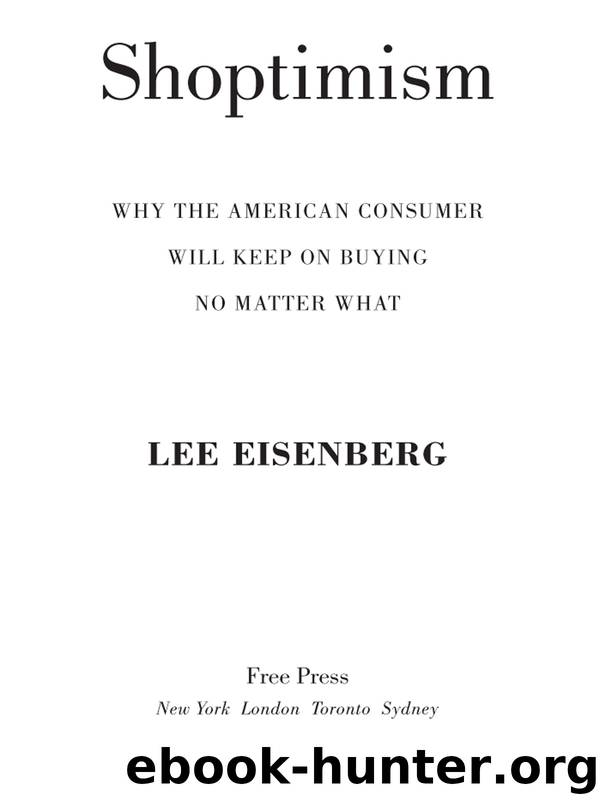Shoptimism by Lee Eisenberg

Author:Lee Eisenberg
Language: eng
Format: epub
Publisher: Free Press
Published: 2009-04-07T04:00:00+00:00
Buy Scolds are of course horrified by the notion that you may be on more intimate terms with the Ti-D-Bowl man than with your own hubby; that you spend more quality time with Aunt Jemima than with your dear Aunt Bertha. How pathetic, Scolds lament, that Ralph Lauren or Rachael Ray or the Pillsbury Dough Boy have become, as psychologist put it, “congruent with self-concept”? The Scolds decry how our infatuation with brand-name motorcycles, computers, dolls, and boxes of interlocking plastic bricks fill those parts of our souls previously occupied by social, moral, and civic ideals. Don’t you see, they sputter, that brands are little more than slick lies—slick lies, says Benjamin Barber, professor of civil society, to which “professional market doctors [surgically attach] generic sentiment”?
Those who promote the potency of brands turn their backs on the Scolds’ disdain. Generic sentiments? Brands are anything but, they counter. Brands, great ones anyway, make our hearts flutter, says Marc Gobé, a global brand-image consultant. Gobé says that “the emotional aspect of products” is a key determinant of why we choose specific offerings and the price we’re willing to pay for them. “By emotional,” Gobé says, “I mean how a brand engages consumers on the level of the senses [and] how a brand comes to life for people and forges a deeper, lasting connection.”
Strong brands are lovemarks, says Kevin Roberts, CEO Worldwide of Saatchi & Saatchi, the advertising mega-agency. Roberts, speaking at a university lecture series, described the circumstances behind his branding thunderbolt: “I live in Tribeca and my wife is in New Zealand.… So, I was there unloved [one night when I] opened up a couple of bottles of red wine and was doodling around at 2:30 in the morning.… I started to draw a little heart, okay? And then I saw heart marks and then love marks.… I thought, I’ve got it, this is so simple. What’s the deepest emotion of all?” Well, love, of course. A lovemark, then, at least as I understand it, is kind of like a brand, but more powerful and affecting than a mere brand because lovemarks, says Roberts, have what it takes to pierce the “heart as well as your mind, creating an intimate, emotional connection that you can’t live without. Ever.” Turn your back on a mere brand, Roberts claims, and you’ll replace it with another. (Nice knowing you, Ban Powder Fresh Roll-on!) Lose a lovemark, though, and you’ll mourn its passing, because lovemarks have three powerful qualities: “Mystery, sensuality, and intimacy,” says Roberts.
Brands, when they’re working right, aren’t mere love vessels, they’re “valuable resources for identity construction”—ours, that is—according to Douglas B. Holt, an American social scientist now teaching at Oxford.* Brands mediate the culture, and certain ones tap into what Holt calls “myth markets,” and thus become “iconic” and highly profitable. Over its brand life, Mountain Dew, for example, is notable for having tapped into three distinct myth markets, growing more successful each time. In the fifties and sixties Mountain Dew played
Download
This site does not store any files on its server. We only index and link to content provided by other sites. Please contact the content providers to delete copyright contents if any and email us, we'll remove relevant links or contents immediately.
| Anthropology | Archaeology |
| Philosophy | Politics & Government |
| Social Sciences | Sociology |
| Women's Studies |
Born to Run: by Christopher McDougall(6893)
The Leavers by Lisa Ko(6802)
iGen by Jean M. Twenge(5161)
Sapiens by Yuval Noah Harari(5120)
The Kite Runner by Khaled Hosseini(4950)
Spare by Prince Harry The Duke of Sussex(4784)
Bullshit Jobs by David Graeber(3826)
Machine Learning at Scale with H2O by Gregory Keys | David Whiting(3611)
Livewired by David Eagleman(3533)
Never by Ken Follett(3520)
Goodbye Paradise(3444)
Fairy Tale by Stephen King(2942)
A Dictionary of Sociology by Unknown(2849)
Harry Potter 4 - Harry Potter and The Goblet of Fire by J.K.Rowling(2799)
The Social Psychology of Inequality by Unknown(2759)
The Club by A.L. Brooks(2745)
People of the Earth: An Introduction to World Prehistory by Dr. Brian Fagan & Nadia Durrani(2619)
0041152001443424520 .pdf by Unknown(2592)
Will by Will Smith(2573)
